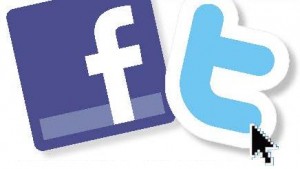What is it about social media that is so intriguing? Is it the possibility of communicating with someone halfway around the world, befriending someone you have never met, discovering people you might never have known, sharing intimate details of your life and learning the same about others, conversing with a large number of people all at once, all of whom share a common interest? Or is it simply being enlightened about new thoughts and ideas, discovering new horizons, and boldly going where you could never have gone before?
As it turns out, it’s all of these reasons and much more. I’m just enthralled with social media, as are many of you. In fact, I asked a number of colleagues to share their thoughts on social media. Some are from New England where I live, a few others scattered across the United States and Canada, and a couple from around the world; some older, some  younger. They had a lot to tell me.
younger. They had a lot to tell me.
So here, for your edification, enlightenment, and enjoyment, I present a treatise on social media and its role in communication.
Is Social Media Preferable to Face-to-Face Communication? Social media enables you to broadcast your messages to a larger audience, not just a single person, in an electronically social manner. You can:
- Easily start a dialogue or a group discussion.
- Use services like LinkedIn, Twitter, and Facebook.
- Use blogs, wikis, and other collaboration tools.
- Post photos, audio files, and video files.
Social media allows you to interact with thousands of people who share similar interests regardless of time, distance, schedule, language, position, or experience—people you do not know and would never know. This is simply not possible with face-to-face communication.
Social media is especially well suited for one-to-many communication, something that is more difficult in face-to-face communication even when such a situation is scheduled ahead of time. Social media allows you to send your message to a select group of people, either a group that you invite or a public group that any interested party can join. You can also monitor the messages of these groups or other groups simply because you find them interesting. You can participate or just listen and learn. In this way, social media is a powerful method of communication.
“Online interactions offer the potential for asynchronous conversations that transcend both time and location,” notes Tom Johnson (www.idratherbewriting.com). Social media is asynchronous: when you are ready to send out your message, you do it. Those receiving your message can listen to it—or not—when it is convenient for them. Face-to-face, on the other hand, is synchronous: you can only send out your message when those receiving it are physically present.
Through social media, you focus more on the person—what they say, who they are—than on physical indicators of looks, dress, nationality, and other factors that tend to create judgments and perceptions. That’s a good thing. Unfortunately, you cannot focus on some extremely valid communication indicators such as body language, tone of voice, and inflections. That tends to mislead sometimes.
In addition, social media offers an archival, historical, searchable record, something that face-to-face communication cannot provide. For some, face-to-face interaction is more efficient; for others, social media is preferable. While I prefer face-to-face, real-life interactions, that is not always possible. In fact, it is rarely possible since many of the people I communicate with do not live anywhere near me. In fact, I have no idea where some of them live. With social media, that physicality is not necessary. You send out your message and people respond if and when they want.
Social media is immediate communication without borders. Social media is exponential and viral, allowing people to pass along messages to an ever-growing circle. Telephones and email didn’t replace face-to-face communication, so social media will not either. Social media isn’t necessarily preferable to face-to-face interactions, it’s just another method of communication (albeit one that alters the landscape considerably).
Some People Prefer Social Media. Social media allows you to keep in touch between those times when you can actually meet. And during that time, you can build a more solid relationship with strong and constant communication; then there isn’t so much catching up to do when you do meet. You can even build relationships with people you have never met, and probably never will. I meet a number of people every year at the STC annual conference. I then see many of them a year later at the next conference. In between, social media allows us to keep in touch.
You can carry on conversations using social media, just as you might while sitting around a table. Indeed, you can enrich a conversation with social media. There is no constraint of time and space—you can contribute at any time, from anywhere.
Some people use social media to communicate with colleagues who sit just down the hall at work. Why? It’s concise and succinct, and eliminates the need for small talk. (I, on the other hand, enjoy small talk, as it gives me the opportunity to widen the conversation to more engaging and revealing topics. Besides, I get to watch body language and facial expressions, gauge gestures, make eye contact, listen to intonations, and feel someone’s presence. All of this is missing in social media.)
 Some people are simply better at communicating in writing, photographs, video, or audio. For them (introverts, I’m calling your name), communicating through this media feels effortless. As such, social media levels the playing field for introverts. “I would rather a sharp stick stuck in my eye than make small talk at a public event, but I can be very gregarious in social media,” says Rahel Bailie.
Some people are simply better at communicating in writing, photographs, video, or audio. For them (introverts, I’m calling your name), communicating through this media feels effortless. As such, social media levels the playing field for introverts. “I would rather a sharp stick stuck in my eye than make small talk at a public event, but I can be very gregarious in social media,” says Rahel Bailie.
“There’s a certain ‘push’ to the technology,” states John Hedtke. You wouldn’t call someone at 11 in the evening, but you can certainly contact them through social media. And if they happen to be online, you can have a synchronous conversation.
Finally, people prefer social media because they can control the level of intimacy and reaction time. As Sherry Michaels (www.docntrain.com) notes, “I know people who text instead of calling because it allows the arm’s length to think through issues before responding.” You don’t need to be spontaneous; social media allows you the time to be thoughtful.
How People Act in Social Media Settings. Social media has opened a rich electronic communication experience, so people are much more open. “By integrating text, photos, and video to a targeted audience, I see a tendency to share more information in richer formats than would ordinarily be shared with that same social set,” opines Lori Fisher.
“‘Social weather’ is more difficult to discern in social media settings than it is in the real world,” says Anne Gentle (www.justwriteclick .com). For example, consider a five-star restaurant replete with white table cloths and a live harpist playing softly. With some rudimentary auditory and visual observations, you would know how to act. When you enter a forum or other social media setting, the process isn’t as obvious. You must observe for a while and read quite a bit before accurately interpreting the social weather for that particular forum. Then, you can participate at a level that everyone else expects.
Understanding that there is another person reading your message is sometimes forgotten. That happens when people are too bold or cutting with their messages, or simply not careful with how their message is crafted. Tone is inferred when none was intended. As a result, people are insulted and offended, rightly or not. Repair can oftentimes appear disingenuous.
Anonymity can also be a problem, with people hiding behind an alias rather than their true identity. Age, gender, and true intentions are easily masked. This contributes to a release of pent-up hostility and becomes exacerbated on blog commentaries and forums. Social media becomes a tricky medium under these highly emotive circumstances. Even something written in jest can easily be misinterpreted. While there is great opportunity in social media, there is also great danger in miscommunication.
As Char James-Tanny (www.helpstuff.com) points out, “The world is listening, even to your ‘private’ conversations.” Social media messages and conversations are permanent. Everything that you post is stored on a server somewhere on the planet and is easily retrieved through search engines.
Social media presents an incredible communication opportunity in which the world is your audience. You can meet all sorts of people from all walks of life who share a common interest. What you write can quickly traverse the planet. You expand your horizons and gain a global viewpoint.
—Rich Maggiani
[Note: This post originally appeared in my “Social Media Insights” column in the March 2010 issue of Intercom, the magazine of the Society for Technical Communication (STC).]